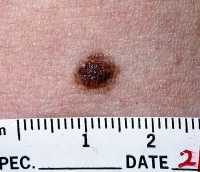06 Sep Study Finds Only 1/3 of Melanomas Arise in Pre-Existing Moles
MedicalResearch.com Interview with:
Riccardo Pampena MD and
Caterina Longo, MD, PhD
Dermatology Unit
University of Modena and Reggio Emilia
Arcispedale Santa Maria Nuova-IRCCS
Reggio Emilia Italy
MedicalResearch.com: What is the background for this study? What are the main findings?
Response: High heterogeneity has been reported in previous studies on the ratio of melanoma associated with moles (nevus-associated melanomas).
Despite this heterogeneity, researchers agree that some melanomas may develop in conjunction with a pre-existing mole.
We know that nevus-associated melanomas are usually located on the trunk and more frequently occur in younger patients than de novo melanomas (not nevus-associated).
Defining the risk for a melanoma to arise in association with a pre-existing mole is important in order to define the best strategies for early melanoma diagnosis.
The main finding of our study is that only one third of melanomas arose from a pre-existing mole, in fact the majority were de novo.
We also found that nevus-associated melanomas were less aggressive than de novo.
MedicalResearch.com: What should clinicians and patients take away from your report?
Response: Patients and physicians should be aware that a patient with a lot of moles is at higher risk to develop a melanoma but themelanoma will likely appear on his skin without moles!
For this reason, complete skin examination could be a more effective follow up than follow up of selected atypical nevi alone for early melanoma diagnosis.
MedicalResearch.com: What recommendations do you have for future research as a result of this study?
Response: Future research should define why certain melanomas are associated with nevi.
In fact, even though chance could play a role, this association occurs more frequently than it would be expected by chance alone.
Also, the less aggressive behavior of nevus-associated melanoma should be confirmed by future studies.
MedicalResearch.com: Is there anything else you would like to add?
Response: The last finding of our study regards association of nevus-associated melanomas with atypical (dysplastic) or non-atypical (non-dysplastic) moles.
We found no differences at this purpose; this seems to indicate that melanoma doesn’t develop from malignant degeneration of a pre-existing mole even when it is nevus-associated.
MedicalResearch.com: Thank you for your contribution to the MedicalResearch.com community.
Citation:
Riccardo Pampena, MD et al. A meta-analysis of nevus-associated melanoma: Prevalence and practical implications. Journal of the American Academy of Dermatology, August 2017 DOI: 10.1016/j.jaad.2017.06.149
https://www.sciencedaily.com/releases/2017/08/170829093534.htm
Note: Content is Not intended as medical advice. Please consult your health care provider regarding your specific medical condition and questions.
[wysija_form id=”5″]
Last Updated on September 6, 2017 by Marie Benz MD FAAD

